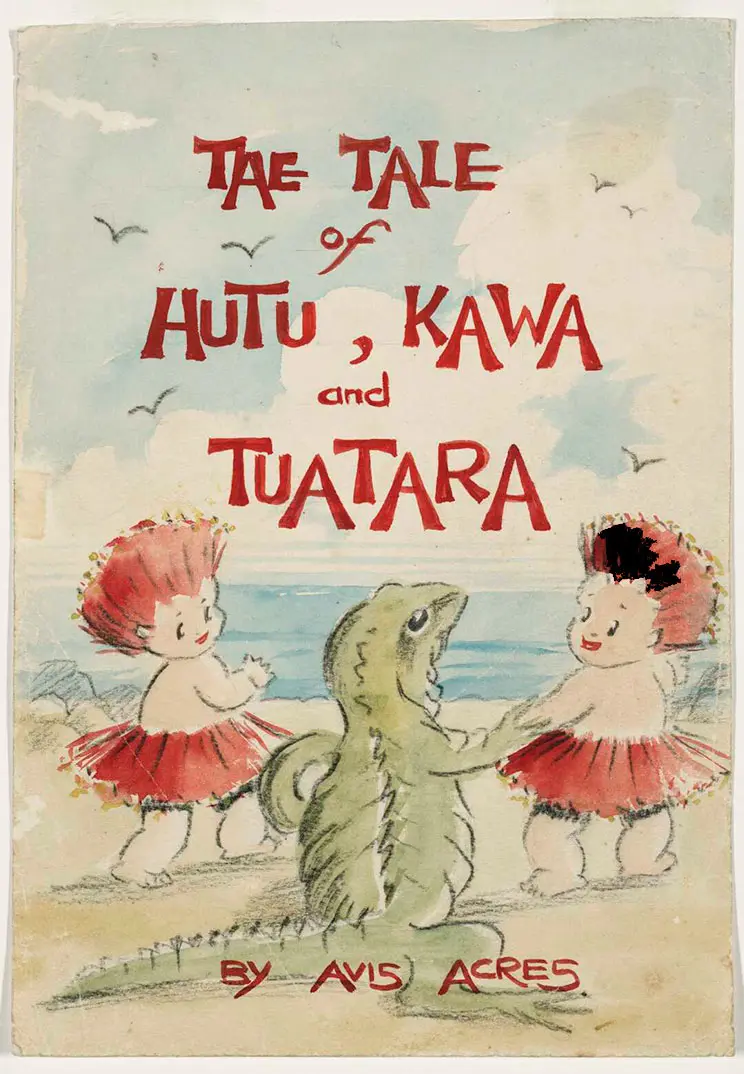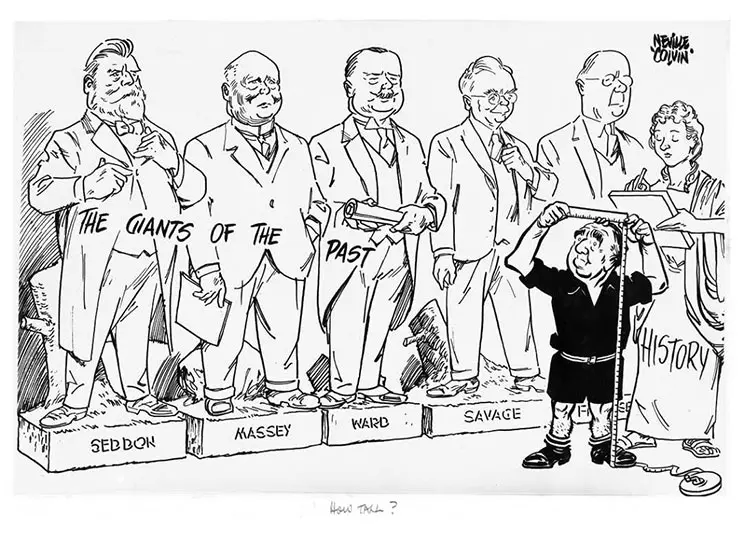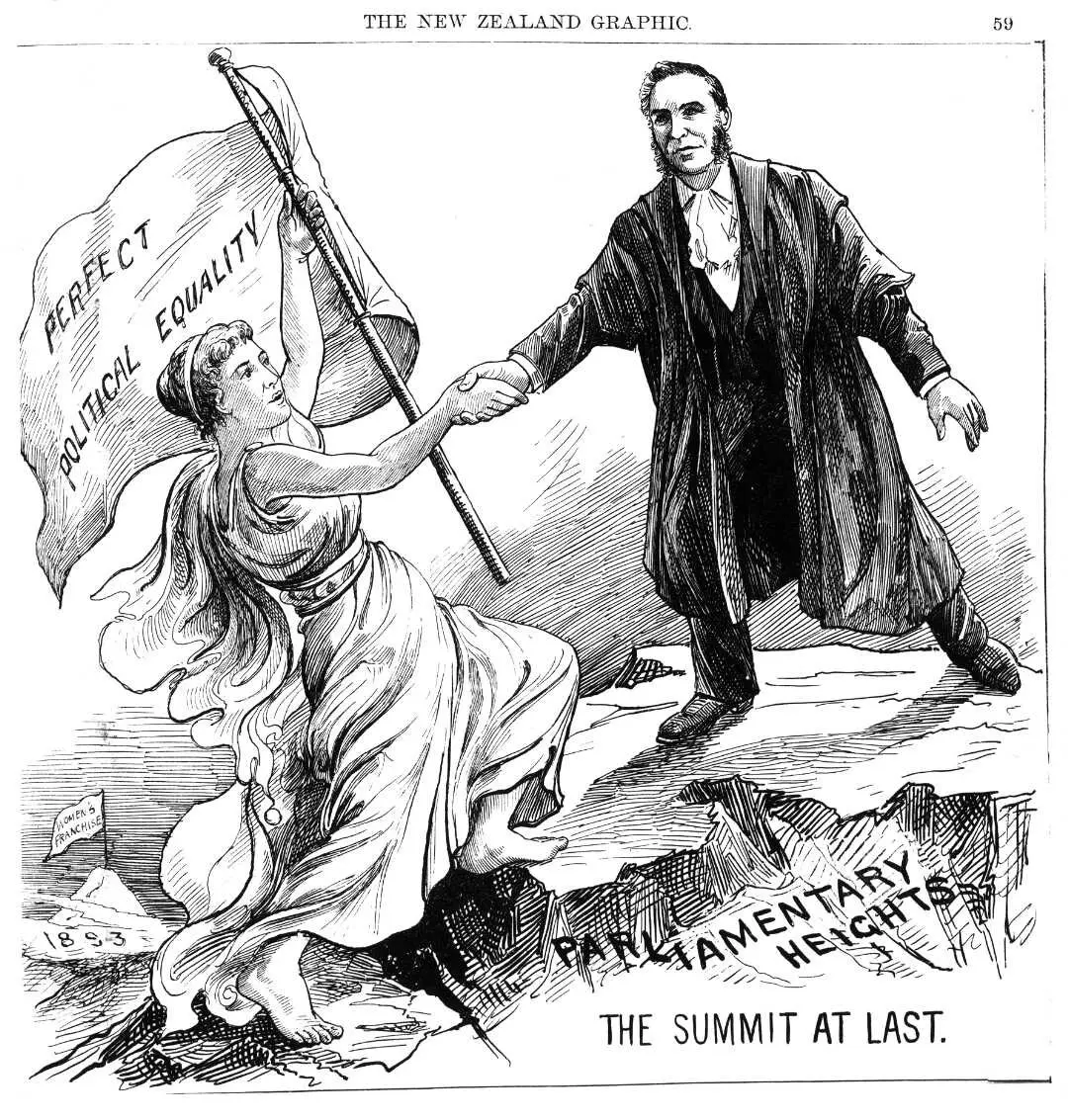Showcasing 30 years of the Cartoon and Comics Archive
We are celebrating 30 years of the Cartoon and Comics Archive with an online exhibition. Read about the the cartoons and comics explored in this online exhibition.
Cartoons and comics of New Zealand online exhibition
This year marks the 30th Anniversary of the New Zealand Cartoon Archive. The Archive has now been renamed the New Zealand Cartoons and Comics Archive to reflect the expansion of scope. To celebrate I have created an online exhibition called Cartoons and comics of New Zealand.
The Cartoons and comics of New Zealand exhibition features five galleries highlighting cartoons and comics in the Alexander Turnbull Collections, as well as important visual material from other institutions.
Kiwi running and shouting "Hang on! Wait for me." The Kiwi is wearing a soldier's helmet, holding a gun and bag with a cross on it.
Early Cartoons and Comics
Let's take a walk through the galleries, beginning with ‘Early Cartoons and Comics’. This gallery explores cartoons and comics from the 1840s-1940s. Many of the early post-colonial cartoons were published in political satire publications such as Punch magazines, Free Lance and The Observer.
During the 1910s the most notable cartoonists include William 'Blo' Blomfield, who began drawing for The Observer in 1887 before jointly buying the paper in 1892. David Low cut his cartoonist teeth in New Zealand before moving to Britain and becoming one of the foremost cartoonists of his generation. John Gilmour took over from David Low as the cartoonist for The Canterbury Times in the 1910s and was cartooning regularly for Free Lance and the New Zealand Truth in the 1920s.

Oh £! by William Blomfield. Ref: A-312-1-080. Alexander Turnbull Library.
Women’s voices emerging
By the 1920s, women were emerging as important voices in New Zealand comics. Their work was often featured in comic strips for children; Avis Acres began her comics career in 1929 with The Adventures of Twink and Wink the Star Babies and was still producing comics in the late 1940s with her Hutu and Kawa series. Rita Angus produced at least three comic series for The Press in the mid 1930s.
Trevor Lloyd was also contributing his skills to children's stories – illustrating a number of children's books, as well as being an editorial cartoonist for the New Zealand Herald. Former Cartoon and Comics Librarian for the National Library, Hannah Benbow, has written about the history of New Zealand comics for children in this article for The Sapling Early New Zealand Comics for Children (thesapling.co.nz)

Acres, Avis, 1910-1994. Acres, Avis, 1910-1994: Book cover of The tale of Hutu, Kawa and Tuatara, by Avis Acres. Ref: B-087-031. Alexander Turnbull Library.
Prime Ministers
Our Prime Ministers gallery highlights some of the most frequently lambasted subjects of cartoons. We've chosen one cartoon per Prime Minister, which was quite difficult to do! So please do have a look through the Cartoon and Comics Archive and search for other images of your favourite (or least favourite) Prime Minister.

‘How tall? The giants of the past’, 15 June 1955, by Neville Colvin. Ref: C-132-890. Alexander Turnbull Library.
Cartoons and comics about war
Cartoons and Comics during wartime can be powerful tools of provocation and propaganda, as ways to educate, or just to provide some relief. This gallery explores the use of cartoons across different wars that New Zealand has been involved in. If you're interested in the way cartoons have been used during wartime it's well worth reading Sarah Murphy's A Cartoon War, which examines the cartoons from World War I and their importance as historical sources.
New Zealand stories and histories
Comics and cartoons are significant and valuable historical source material, they can highlight everyday attitudes and the focus on the social attitudes of the time of their creation. This gallery looks at the range of ways cartoons and comics have been used.
We invite you to look at how comics have been used to tell stories about the influenza, as well as offer solutions (tea?) — and reflect on how comics have been used throughout our lates pandemic. Cartoons also provide commentary on issues of the day – such as the suffrage movement. I especially appreciate Sharon Murdoch referencing a cartoon in our collection to make a point about equality.
‘The Summit At Last’, engraving by an unknown artist, 1894. Ref: PUBL-0126-1894-01. Alexander Turnbull Library.

‘How far we've come.’, 23 September 2015, by Sharon Murdoch. Ref: DCDL-0031650. Alexander Turnbull Library.

New Zealand has a history of great comic strips and we've included some of them in the New Zealand stories and histories gallery. We've included Burton Silver's Bogor, David Fletcher's The Politician and of course Murray Ball's classis Footrot Flats_.
Comics can also be tools of education and used to tell our histories. Ross Gore's comics of the 1950s told detailed New Zealand histories in comic form, you can read more about him on the Pikitia Press blog. There are many other comics in our collection that use comics for telling our histories, or for education. One of my favourite comic series is the [Kia Mataara series](/records/22152219?, a resource created in the late 1990s by the Kia Mōhio Kia Mārama Trust. The comics, drawn by Moana Maniapoto, are an incredible resource for understanding the historic and current impacts of colonisation. They can also be used as a call to action, to highlight diversity, or express empathy.
Some moments in cartoons and comics histories
Our final gallery explores some little moments in comics histories and events. In the 1950s, on the release of the Mazengarb Report, many comics were censored — as they were said to be contributing to 'Moral delinquency in Children and Adolescents'. This decimated the comic industry for a long time. Over the years comics collectives like Funtime Comics, and events like Armageddon and Zinefests have helped to nurture comics communities in New Zealand. Today we see a range of cartoonists and comic artists flourishing.
If you'd like to read more about the history of Cartoon and Comics in Aotearoa be sure to explore these articles on Te Ara.
History of Comics and Graphic Novels in Te Ara
History of Cartooning in New Zealand in Te Ara Encyclopedia
What’s missing in this exhibition?
This online exhibition is by no means intended to be a complete display of New Zealand cartoon and comic histories and we invite you to examine what is missing in this exhibition, as much as we encourage to look at what is display. With over 60,000 cartoons and comics in our collection we have only a portion digitised and available for online display. It is well worth exploring the Cartoon and Comics Archive to see what else we have in the collection.
We are actively seeking to collect works that have previously been out of scope (for example comic works), as well as works and artists that may have been missed over our first 30 years. The Cartoon and Comics Archive is a part of the Contemporary Voices team, which has a focus on addressing the silences and gaps in our collections. Our aim is to create a more participatory and inclusive documentary heritage. You can read more about our approach here.
We're currently finalising the priority collecting areas for the Cartoons and Comic Archive. If you'd like some more information about this get in touch with me at sam.orchard@dia.govt.nz
Cartoon and Comics Archive 30 years from now
It's likely that the exhibition for the next 30 years of the Archive will look quite different from this one. Editorial cartooning is evolving as the landscape of print media shifts, and memes on social media are rapidly becoming a medium of social and political critique. Social media is also providing platforms for emerging voices in contemporary issues, and it's fast becoming a place where editorial style cartooning is finding new territory to take root.
Comics have already experienced a (r)evolution with the rise of the internet and the development of webcomics. There has been an explosion of diverse voices heralded by the democratisation of user generated content on the internet. Anyone, anywhere can find their audience across the world. This has meant there is a massive increase in the breadth of who are creating comics, and how they are able to reach and sustain audiences.
New Zealand's own Rachel Smythe is creating Lore Olympus, which is consistently one of the world's most read webcomics. Lore Olympus won the 2022 Eisner award for best webcomic and has had back to back wins for Digital Book of the Year at the Harvey Awards. Rachel is in good company with Kay O'Neill, author of the ‘Tea Dragon’ series, who are the only New Zealanders to win both Eisner and Harvey awards.
Toby Morris and Siouxie Wiles’ COVID-19 graphics went viral (in the good way) as easy explainers dealing with the virus. There are a number of publishers who are using graphic novels to encourage young readers, and apps using the power of comics to share uniquely New Zealand stories.
The future of cartoons and comics in New Zealand is bright!
Explore the online exhibition
We hope that you enjoy our online exhibition to celebrate the 30th Anniversary of the New Zealand Cartoons and Comics Archive. We welcome your thoughts so let us know what you think. Either use the comments section below or get in touch with me at sam.orchard@dia.govt.nz.
Cartoons and comics of New Zealand
Find out more about the Cartoon and Comics Archive
Cartoon and Comics Archive
Cartoons and comics research guides
Blogs about cartoons and comics in our collections
Cartoons about the 1981 Springbok tour